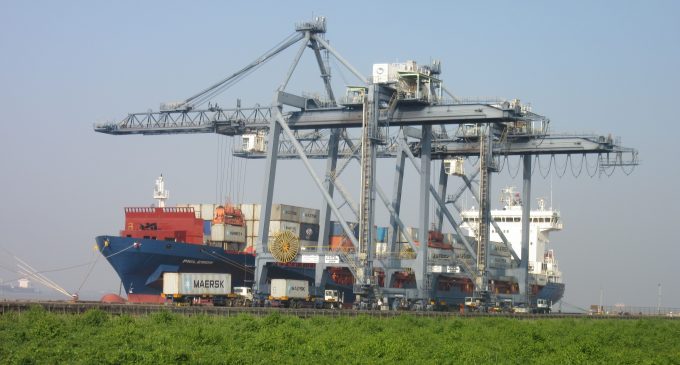Liner industry frustration as India demands millions in taxes
Foreign-flagged container shipping lines facing the heat from Indian tax authorities have been lobbying the ...
GM: RAISING THE ROOF GGM: IN FULL THROTTLE GZIM: MAERSK BOOST KNIN: READ-ACROSSMAERSK: NOT ENOUGHMAERSK: GUIDANCE UPGRADEZIM: ROLLERCOASTERCAT: HEAVY DUTYMAERSK: CATCHING UP PG: DESTOCKING PATTERNSPG: HEALTH CHECKWTC: THE FALLGXO: DEFENSIVE FWRD: RALLYING ON TAKEOVER TALKODFL: STEADY YIELDVW: NEW MODEL NEEDEDWTC: TAKING PROFIT
GM: RAISING THE ROOF GGM: IN FULL THROTTLE GZIM: MAERSK BOOST KNIN: READ-ACROSSMAERSK: NOT ENOUGHMAERSK: GUIDANCE UPGRADEZIM: ROLLERCOASTERCAT: HEAVY DUTYMAERSK: CATCHING UP PG: DESTOCKING PATTERNSPG: HEALTH CHECKWTC: THE FALLGXO: DEFENSIVE FWRD: RALLYING ON TAKEOVER TALKODFL: STEADY YIELDVW: NEW MODEL NEEDEDWTC: TAKING PROFIT

Maersk Line and its intra-Asia arm, MCC Transport, have expanded their direct service linking China and Myanmar by adding the Pearl River gateway ports of Yantian and Hong Kong.
Launched in February 2015, the Intra-Asia 5 (IA5) service now departs from Shanghai and calls at Ningbo, Hong Kong, and Yantian on its way into Yangon, Myanmar, where it calls at two terminals before a string of south-east and north Asia ports on its return leg.
Dawid Sold, Maersk Line country manager for Myanmar, told The Loadstar the decision to expand the service was based on sufficient utilisation since its launch and the expected steady volume growth of Yangon’s container trades.
“It [the expansion] is a big revolution for this market, as this is the first service operating with these ports as a direct connection,” Mr Sold said.
The IA5 had included a call at Ho Chi Minh City, Vietnam, but this has now been switched to a new direct service combined with Bangkok.
“So, right now we have Vietnam and Thailand direct to Yangon, and we have four Chinese ports direct as well, which makes us the most well-connected shipping line in terms of Yangon’s biggest trading port partners,” added Mr Sold.
The service has not been without its challenges, however, added Mr Sold.
He explained that despite sufficient utilisation levels on its 1,300 teu vessels, the IA5 has not been exempt from the general rate deterioration, and profitability has been an uphill task since vessels are leaving Yangon with boxes mostly empty.
“The biggest challenge is that there’s only one-way traffic. Depending on the seasonality and the cargo mix, it’s anything from 40:60 to 20:80 in terms of the proportion between export and import,” he said.
However, Mr Sold believes exports will start picking up as Myanmar’s industries modernise and economic growth gains traction. The Asian Development Bank is predicting Myanmar will achieve 8.4% economic growth in 2016, with garments and tourism performing well and agriculture rebounding after last year’s Cyclone Komen destroyed a fifth of the country’s cultivated land.
Meanwhile, large-scale increases in container volumes could place a strain on Myanmar’s underdeveloped ports and road network.
In Yangon, through which the vast majority of container traffic flows, the downtown river-terminals are already approaching capacity during peak season with little room for expansion, according to Mr Sold.
Asia World Port (AWP) and Myanmar Industrial Port (MIP) handle most of Yangon’s container throughput, approximately 728,000 teu in 2014, up 19% on the year before. Located adjacent to Yangon’s main industrial area, the two terminals are impacted by city-wide congestion and a lack of storage space.
There is capacity for traffic to switch to the deeper port at Thilawa Special Economic Zone, 20km south, where the Hutchison Ports-operated Myanmar International Terminal Thilawa (MITT) sits underutilised. However, although the IA5 does call at MITT in addition to MIP, Yangon’s shippers are largely shunning the out-of-town port due to the added haulage costs.
“We could bring bigger vessels into Thilawa, as the river access is a little bit different from the downtown terminals, but the majority of the customers are either in the city itself or north of it,” Mr Sold explained. “Thilawa has the potential to be a massive industrial zone, but really we’re talking about the next five or 10 years, if the manufacturing moves there.
“The common perception is that Myanmar is a super attractive market, and it is – but nobody knows the time perspective,” he added.
Comment on this article